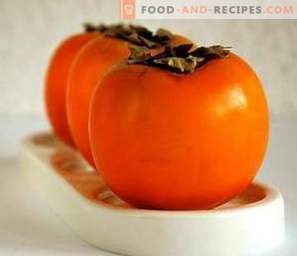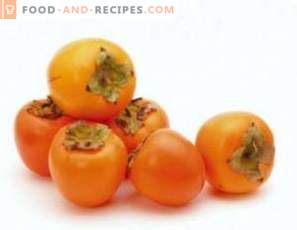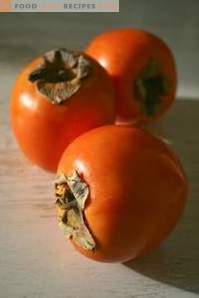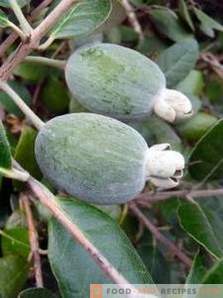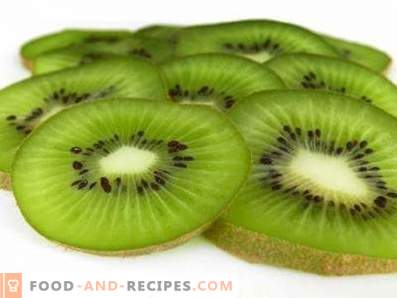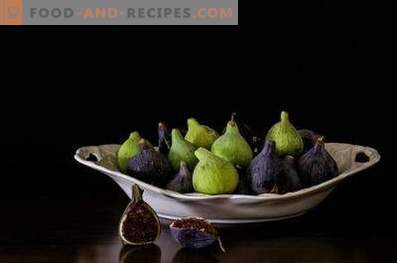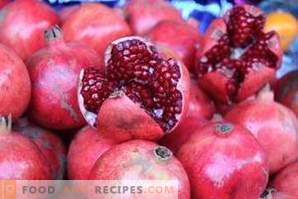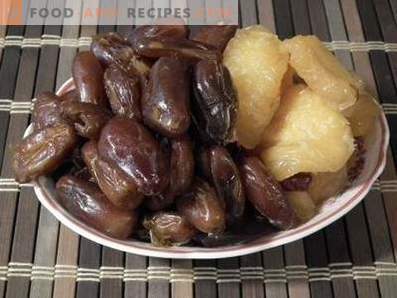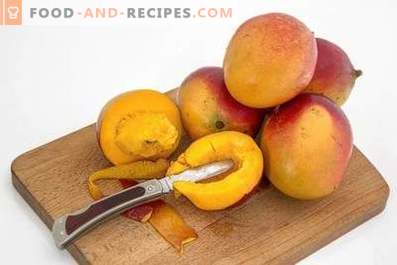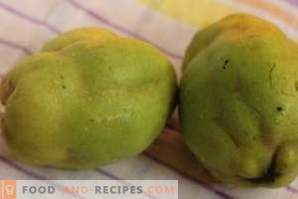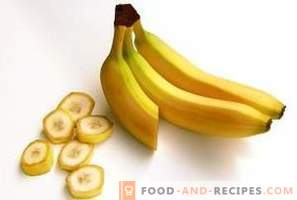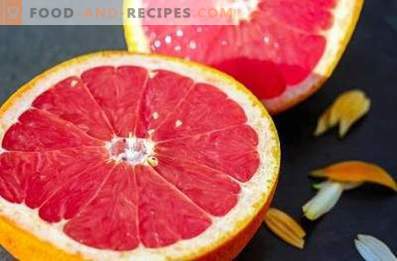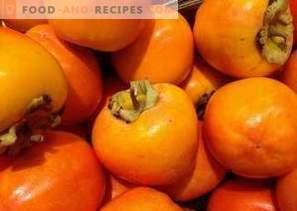
Persimmon belongs to the genus of deciduous or evergreen trees or shrubby plants of the Ebony family. Geographically, the species is classified as tropical and subtropical plants. Persimmon trees can live up to five hundred years. The name of the genus in Latin Diospyros came from Greek and in various versions means “food for the gods” or “divine flame”. The Russian name “persimmon” is borrowed from Farsi (the language of the indigenous people of Persia) and is derived from the phrase “date plum” - “Hormal”. The first half of the word “horma” corresponds to the date, and “alu” corresponds to plum. Initially, the word “Khormalu” was called the Caucasian variety of fruits. The connection with dates is in the similarity of their taste with dried persimmon. Later, the term “persimmon” entrenched for all species of this plant, including the Japanese variety. Also, trees with edible fruits can be called wild dates or date plums.
Many people know that China is the birthplace of persimmon. Acquaintance of European countries with the plant occurred relatively recently. In 1896, 12 seedlings from the Land of the Rising Sun arrived in the Georgian port of Batumi. A few decades later, full-fledged cultivation of imported tree species began in Europe. The first persimmon trees grow around Beijing for more than a century, and some even reach the age of 600 years.
The persimmon stem root system goes extremely deep into the soil. The crown is shaped like a vessel with bulging walls. Thick brown trunk of trees usually has a radius of 20-30 cm. Persimmon leaves are distinguished by a variety of possible forms: they resemble an ellipse, egg, heart, wedge or oval. The upper surface is very smooth and bright green, and the lower one is lighter and rough. Flowers are male, female and mixed type. Persimmon blooms in late spring, and the fruits ripen in late October, after most of the leaves fall. Most of the representatives of this genus fruits are edible. These 1-10-seed berries, when mature, have a bright orange color and dark leaves, and to the touch - soft, smooth and fleshy. Often consumers are provided with unripe persimmon, better preserved fresh. In this case, you can hold it in the freezer or under warm water. Both variants of temperature conditions remove tannin in the composition of the pulp and, therefore, astringent taste. You can often find round fruits with dark flesh and bones. Such berries are called “King”, and they can be consumed without ripening. It is a mistake to refer them to another variety, because on the same tree you can see the usual fruits of persimmon and blood orange dots. The difference is that the second type of fruit obtained by pollination of flowers.
In nature, persimmon is common in the tropical belt, but is currently actively grown in many countries with a warm climate. The largest volumes of market supplies of persimmon provide the Indo-Malaysian region, the southern regions of Eurasia, America and Australia. Some territories have their own endemic (unique) species. Among the 1500 varieties of various persimmon emit some exotic. For example, berries from South America are called “chocolate pudding” or “black apple”, which is associated with the taste and appearance of the fruit when ripe. On the Philippine Islands there is a special variety of persimmon, called “velvet apple”. In Paraguay, grow persimmon trees with flat berries. Very tiny fruits of persimmon (up to 2-3 cm) can be found in the gardens of the Caucasus. Very popular is the variety “Sharon”, obtained in Israel and having a specific pleasant mild flavor due to a small amount of tannin. Several types of persimmon are used as a source of quality wood.
Nutrition and vitamin value of persimmon fruits
In all varieties of persimmon contains a large amount of glucose, ascorbic acid, provitamin A, as well as organic acids (mainly citric and malic).
Nutritional value 100 g of berries:
- 0, 55 g of proteins;
- 0, 39 g of fat;
- 15, 7 g of carbohydrates;
- 1, 63 g of dietary fiber;
- 0.11 g of organic acids;
- 81, 6 g of water;
- 0, 12 g of unsaturated fatty acids;
- 0, 12 g of saturated fatty acids;
- 15, 4 g of monosaccharides and disaccharides;
- 0, 58 g of ash.
Many vitamins in the composition of persimmon can provide part of the daily allowance for an adult organism.
Vitamins per 100 g of persimmon:
- 1, 24 mg of beta-carotene (vitamin A provitamin);
- 200, 3 μg of retinol equivalent (A);
- 15, 02 mg of ascorbic acid (C);
- 0, 021 mg of thiamine (B1);
- 0, 032 mg of riboflavin (B2);
- 0, 33 mg of niacin equivalent (PP);
- 0, 19 mg of vitamin PP;
- 0, 53 mg of tocopherol (E).
Calorie content of fresh persimmon
As a rule, one persimmon fruit weighs from 100 to 600 grams. Sweeter persimmon varieties contain more calories, but the differences in energy value are small.
- 100 g of persimmon contain 67 kcal.
- Medium-sized berry (90 g) contains 60, 3 kcal.
A similar mass of other popular persimmon varieties corresponds to the following caloric values:
- Kinglet - 54 kcal;
- Sharon, Victoria - 68 kcal;
- chocolate persimmon - 61 kcal.
During thermal and other processing, you can get dried or dried persimmon. The caloric content per 100 g will increase significantly, since due to a decrease in the water content, the fruits lose a lot of weight while maintaining the same composition.
- The caloric value of 100 g of dried persimmon is 231 kcal.
- The caloric content of 100 g of dried persimmon is 246 kcal.
Nutritionists consider a persimmon to be a high-calorie product. Nevertheless, due to the low content of proteins in the berries, their use does not lead to an increase in muscle mass.
Mineral composition of persimmon fruits
Persimmon fruits are rich in iron and iodine, and among the macronutrients available in the pulp are calcium, potassium, magnesium, and phosphorus.
Macroelements per 100 g of persimmon:
- 127, 02 mg of calcium (Ca);
- 200, 04 mg of potassium (K);
- 56, 03 mg of magnesium (Mg);
- 42, 05 mg of phosphorus (P);
- 15, 03 mg of sodium (Na).
Trace elements in 100 g of persimmon:
- 2, 53 mg of iron (Fe);
- 0.054 mg of iodine (I).
Useful properties of persimmon
- In eastern countries, persimmon is an important part of the daily diet. The Japanese and the Chinese are trying to eat at least 2-3 berries a day, and this meal is considered a full meal. The fruit is a large amount of dietary fiber - about 25% of the daily requirement. The digestion of these components takes place over a sufficiently long period of time, therefore, after taking persimmon for a long time, one feels full. This berry is often recommended for children and those who experience significant physical exertion.
- Persimmon is classified as a dietary product due to the presence of pectin in its pulp, which solves problems in the digestive processes, removes toxins. In folk medicine, the fruits are recommended for the detection of gastric diseases and scurvy.
- The sweet taste of persimmon owes a high concentration of sugars, that is, fructose and glucose. These components are very important for the cardiovascular system and the maintenance of optimal blood sugar levels.
- The high nutritional value of persimmon can be compared with similar qualities of grapes, raisins and figs. Sweet dried berries are often consumed during tea drinking instead of pastries. In the pulp of persimmon there is so much glucose that when drying fruits, it appears on the surface (like frost).
- Vitamin C has an antiviral effect, and beta-carotene helps combat vision and skin problems. Vitamins of group B and PP and iron salts are also present in persimmon, which in total has a strong positive effect on blood-forming processes. Doctors often advise people with high blood pressure or cardiovascular problems to take persimmon.
- Some patients are prescribed diuretic therapy, the use of which enhances the excretion of potassium from the body. To replenish the stocks of this important element, it is enough to diversify the diet with the addition of persimmon, apples and apricots.
- The persimmon fruit contains twice as many trace elements and antioxidants as apples. Also described berries provide the body with impressive reserves of iron, calcium and magnesium. The last element is responsible for the prevention of the appearance of kidney stones. Anti-cancer properties of persimmon owes a high concentration of vitamin A. Berry is so effective against the risk of lung cancer, that on the advice of doctors used by smokers with experience. Ascorbic acid and vitamin P make blood vessels strong. B vitamins normalize the activity of the nervous system. Iodine in the composition of the fruit stabilizes the thyroid gland.
- A large amount of sugars and potassium in persimmon juice contributes to a surge of strength and relieve fatigue. Fruits have a calming effect on the nervous system and give energy.
- Due to the diuretic and tonic effect of the berries can relieve swelling.
- The bactericidal action of persimmon extends to intestinal and hay bacillus, Staphylococcus aureus.
- Low acidity of persimmon allows its use for the treatment of diarrhea, dysentery.
- To narrow the pores and restore the inflamed skin, cosmetologists recommend a mask of unripe persimmon fruits in combination with egg yolk and lemon juice.
- A decoction of the leaves or roots of this plant is used in the East as an external means to stop bleeding and disinfect cuts. This broth can reduce pain and reduce inflammation (for example, with hemorrhoids).
- The leaves and young shoots of persimmon have large reserves of vitamin C. If you make an infusion of them, then it will contain 20 times more ascorbic acid than green tea.
Contraindications to the use of persimmon
The beneficial properties of persimmon can be widely used to treat diseases. However, the use of this berry can harm the body in the following cases:
- in diabetes and obesity;
- in identifying problems of the gastrointestinal tract (especially after previous operations);
- in combination with milk and cold water a large amount of persimmon causes intestinal upset;
- like other fruits with a bright color, persimmon can cause an allergic reaction in pregnant women;
- in children under 3 years old when consuming persimmon, constipation is possible (due to the high tannin content).
Persimmon contains pectic substances, sugar and tannic acids in an amount capable of provoking caries and destruction of tooth enamel. Also, the pulp of the fruit has a fibrous structure, because of which the remnants of berries can get stuck between the teeth. Therefore, dentists strongly recommend rinsing your mouth or drinking a glass of water after consuming this berry.
